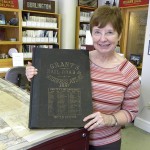
Category Archive: Preservation News
-
Penn Hills Development Group Begins to Bloom
By Tony LaRussa
PITTSBURGH TRIBUNE-REVIEW
Thursday, June 10, 2010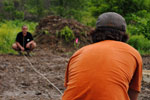
President of the Penn Hills Community Development Corporation Erik Hardy, 58, of Penn Hills works with volunteer Colton Sankey, 17, of Plum High School to form a plumb line as they plot out a community garden. The municipality is allowing the CDC to use a parcel of land along Jefferson Road for a community garden in which residents and groups can rent 4- by 12-foot plots for $20. Samantha Cuddy | Pittsburgh Tribune-Review
Penn Hills’ burgeoning Community Development Corporation took a significant step in its organizing efforts when the state recently designated it as a private, nonprofit organization.
That’s not all. The CDC has a project under way: a community garden.
Since last year, organizers have worked to create an organization to promote the community’s strengths: its location, plentiful and affordable housing, diverse population and parks and other recreation facilities.
Equally important is addressing the poor reputation of the community’s schools, its inability to attract and keep businesses, and the deteriorating quality of life in some neighborhoods caused by crime, poor property maintenance, government-subsidized housing and other factors, officials say.
Working committees include housing, economic development, education, community beautification, public safety and communications. CDC officials are encouraging residents to join the organization and serve on a committee.
“We’ve found that people here have a lot of energy and great ideas for promoting or improving various aspects of the community,” said Erik Hardy, CDC board president. “What we didn’t have was a central place to go to channel that energy and put those ideas into practice. That’s really what led us to form this organization.”
Margie Howard of the Community Technical Assistance Center in Pittsburgh said obtaining nonprofit status from the state is a critical step toward becoming eligible for funding.
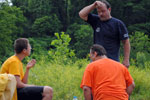
Jim Black, standing, Vice President of the Community Development Corporation of Penn Hills, ponders his next move with fellow workers at the municipality's community garden. David Wolf, right, and his son Gregory Wolf, 13, are helping to construct 4 by 12 foot garden plots which residents and groups can rent. Samantha Cuddy | Pittsburgh Tribune-Review
“You have to have the state designation before applying for federal tax-exempt status,” said Howard, who helped the CDC develop its structure. “There are a lot of state and federal agencies and foundations that require groups to be a tax-exempt, nonprofit organization before they will consider them for grants.”
CDCs operate apart from local government, and money such as federal housing rehabilitation grants are available only to them.
Lack of money has not prevented the CDC from taking on a project its members hope will help spur interest in its activities.
The municipality is allowing the CDC to use a parcel of land along Jefferson Road for a community garden in which residents and groups can rent 4- by 12-foot plots for $20. Municipal officials also have agreed to supply water to the site.
Businesses donated materials, supplies and services for the garden. Penn Hills Lawn and Garden donated soil testing and mushroom manure; Penn Hills Rental provided equipment to clear the site; Hanson Aggregates gave gravel for the access road; and The Home Depot provided lumber, fencing, tools, water barrels and other supplies.
-
Allegheny County Park Structure Inventory Requested Health, Safety Issues Concern Council
Thursday, June 10, 2010By Len Barcousky, Pittsburgh Post-GazetteAn old horse barn in North Park is a good example of a structure that has outlived its usefulness, according to Allegheny County Councilwoman Jan Rea.
“We have a lot of buildings in our parks that have not been used for as long as 20 years,” the McCandless Republican said. “Their windows are boarded up, and some pose a health and safety hazard to residents.”
Allegheny County’s nine parks are home to hundreds of structures, and council has asked the Parks Department to prepare an inventory of every one of them.
Council unanimously passed the building-survey ordinance last week.
It calls for preparing an inventory that will include information on location, condition and maintenance needs for every structure.
The final report is to include a recommendation and cost information on either maintaining or demolishing each building. The measure sets a 120-day deadline for completing the work.
Parks Director Andrew Baechle told council that members his department could make that late-September deadline. The county Department of Public Works is to assist in the effort.
“If it is cost-prohibitive to get a building into usable condition, we should take it down,” Ms. Rea said. “Some of them are crumbling, and they have animals living in them.”
Councilman Nicholas Futules agreed.
“We should know the condition and value of all our buildings,” he said. He is chairman of council’s Parks Committee, which recommended approval of the survey ordinance.
The parks department has a total of 341 rental facilities, which includes groves, shelters, gazebos, houses and other various buildings.
Hundreds of structures have to be painted, patched and updated. North Park, for example, has 119 picnic groves and shelters and at least two dozen other buildings.
The measure defines structures to include offices, barns, houses, picnic pavilions, swing sets, restrooms, changing facilities and locker rooms, greenhouses and nature centers. Creation of the oldest of the parks began in the 1920s and 1930s, and some structures from that era remain in use.
Maintenance is expensive and work on some structures has been deferred, Mr. Baechle said.
Restoration efforts involving one North Park landmark got a boost this month, thanks to a Hollywood movie company.
At the same meeting at which it approved the survey ordinance, council authorized DreamWorks Studios to film scenes for a science fiction movie called “I Am Number Four” in Deer Lakes and North parks.
The production company will pay the county a $10,000 fee.
Most of the money will be used to restore decorative terrazzo tile on North Park’s water tower. The 100-foot tower, or standpipe, was built in 1937 as part of the park’s water supply system. It is recognizable by its exterior spiral staircase that leads to a now-closed observation platform.
While the DreamWorks funds will help with renovation costs, additional work will be necessary before the platform can be reopened, Mr. Baechle said.
That work will include removal of lead-based paint and stairway repairs. The county has no timetable for the project, he said.
-
Elegant Vaudeville-Era Theater in Dormont to be Razed
By Chris Ramirez
PITTSBURGH TRIBUNE-REVIEW
Thursday, June 10, 2010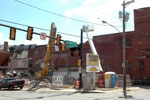
Demolition is taking place at West Liberty and Dormont avenues as the former South Hills Harris Theatre bites the dust. Once the elegant backdrop for countless Vaudeville acts and live-action performances, it will soon be gone, much to the dismay of local historians. It was built in 1927 and opened in 1928. Heidi Murrin | Tribune-Review
Harris moviehouse’s heyday long past, CVS now owns property, hit by vandals, in disrepair.
The final curtain is coming down on the old South Hills Harris Theatre.
Broken windows, stained walls and a partially collapsed roof are all that remain of the once-regal theater on West Liberty Avenue. Soon, the one-time hot spot will be demolished to make way for a pharmacy.
“It’s sad news, as far as I’m concerned,” said Muriel Moreland, president of the Dormont Historical Society, “It’s such a shame because it’s a beautiful building. It’s just one more thing that’s going down, going away.”
Long before there was Dolby Sound, multiplex theaters and six-story IMAX picture screens, there were entertainment houses like the South Hills Harris Theatre, which was the backdrop for countless Vaudeville acts and live-action performances.
It was built in 1927 and opened in 1928. Watching a production there was an experience.
Ushers in tuxedos and white gloves guided theatergoers of the 1930s and 1940s through a main lobby illuminated by the shimmering light of a crystal chandelier. There was no Dolby Sound. For many years, audiences heard just the music of Bob Mitchell, tickling the keys of a Wurlitzer pipe organ.
The site was converted to show motion pictures and short films, including pro-military spots that became popular during World War II.
After years of operation, the theater closed in 2001. Pharmacy giant CVS bought it, along with a corner property and two houses surrounding it, Moreland said. All of them are to be razed, she said.
Despite several fundraising campaigns and efforts to find new owners, the building has been cordoned off from public access, fallen into disrepair and become a magnet for vandalism and animal infestation.
The interior has been gutted. The organ has since been sold to a theater in Ohio. And no one seems to know what happened to the chandelier that greeted theatergoers when they entered.
“One part of it (the theater) is already pretty much rubble,” Moreland said.
Nancy Fenton chronicled the building’s lapse into disrepair over the years, snapping photos of her childhood getaway while walking her dog.
She was a child living in Brookline when she and friends went to see “Psycho” at the theater in the 1960s. “We always made sure we got to sit in the balcony,” said Fenton, 63, of Dormont. “It was like a big opera house.”
Walking there was part of the fun. Coming home later that night was more frightful after sitting through the thriller that “just about did us in,” Fenton said.
“The two houses that were by it had these bushes and trees that used to have branches that were hanging over the sidewalk we’d take to get back home,” she said. “That was spookier than the movie.”
-
Historical Societies Foster Pride and Preservation
By Matthew Santoni
PITTSBURGH TRIBUNE-REVIEW
Thursday, June 10, 2010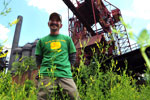
Ronald A. Baraff, director of museums and archives for the Rivers of Steel Heritage Area, which chronicles the history and culture of the industries and mill towns along the rivers, visits the former Carrie Furnace steel mill site in Braddock. Rivers of Steel recently acquired the site from the county to turn into a museum. Sidney Davis | Tribune-Review
The statue of Pittsburgh Pirates legend Honus Wagner might stand outside PNC Park on the North Shore, but fans who desire something more can head six miles down the Parkway West to the Historical Society of Carnegie’s miniature museum to learn about its native son.
In a historic building along West Main Street, a small exhibit on Wagner shares space with yearbooks and photos from area schools, a memorial wall for the town’s military veterans, and a painstakingly crafted scale model of the borough’s buildings along East and West Main Street, all funded without help from the municipality.

Volunteer Joan Harbin points out a model of the building housing the artifacts and exhibits on display at the Historical Society of Carnegie in the small museum on West Main Street. Keeping up with the maintenance of the building and expansion plans has been a struggle, but officials say local history groups, such as the Carnegie's, help to instill local pride and encourage tourism and redevelopment. James Knox | Tribune-Review
“We support ourselves. We figured it was better to be people-funded rather than tax-funded,” said Marcella McGrogan, executive director of the society. “Our town’s streets and parking lots need the help more than we do.”
Carnegie is one of many communities in the region with a historical society, which officials say can encourage economic development by drawing tourists, instilling local pride and marketing a community’s historic assets.
“We have a ‘Babushkas and Hardhats’ tour … that looks at the development of the Pittsburgh region, why industry located here, why it isn’t here now and how Pittsburgh has reinvented itself,” said Ron Baraff, director of museums and archives for the Rivers of Steel Heritage Area, which chronicles the history and culture of the industries and mill towns along the rivers.
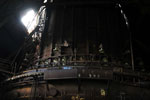
About 15 acres of the former Carrie Furnace steel mill site in Rankin and Braddock were transferred from the county to Rivers of Steel, and officials hope to turn the former blast furnaces into a museum. Sidney L. Davis | Tribune-Review
About 15 acres of the former Carrie Furnace steel mill site in Rankin and Braddock were transferred from the county to Rivers of Steel, and officials hope to turn the former blast furnaces into a museum.
“The idea is to bring people into the region and get them to understand that the past built the present, that that’s the foundation for the future,” he said.
How and why it helps
The Young Preservationists Society of Pittsburgh released a report last month estimating that preserving and restoring historic properties added at least $475 million to Southwestern Pennsylvania’s economy from 2003 to 2009. Local historical societies can encourage such redevelopment and reinvestment by making people more aware of the history of their communities and homes, said Arthur Ziegler, president of the Pittsburgh History and Landmarks Foundation.
“People tend to believe in the value of that area and are more willing to invest, particularly in historic buildings,” Ziegler said. “It can also develop visitor interest, which can bring income to a town.”
The Sewickley Valley Historical Society is too small to maintain a museum space of its own, but its library allows people to research the history of their families or their homes, said Harton Semple, executive director.
“We’re a small society — only about 400 members — but we have a rich history to draw upon,” Semple said. “We are assailed on all sides by development and general apathy, but we’re beating back that tide.”
The Sewickley Valley society’s “nest egg” was hit hard by the recession, but it has sustained itself with members who made donations above and beyond their yearly membership dues, Semple said. The group published a history of Sewickley last year, and is beginning a push to fund and erect historical markers around the area, he said.
The Historical Society of Mt. Lebanon charges a small fee for its “home history project,” which presents homeowners with a report on the architect who designed their houses, construction plans for them and any other tidbits that members of the historical society can dig up, said Executive Director Margaret Jackson.
Mt. Lebanon’s society is entering its second year of operating a small museum space off Washington Avenue, which hosts rotating exhibits on local subjects such as the nearby Washington School or the Mt. Lebanon Soccer League, Jackson said. More and more residents are donating artifacts and photographs, but that raises the new challenge of how to store and protect them all. Yearly contributions from the municipality’s budget are enough to cover rent on the museum space, she said.
“We’re slowly getting the word out that we’re here, that we’re not just for little old ladies,” Jackson said. “Mt. Lebanon is just celebrating our centennial. … Hopefully, we’ll preserve our community’s past for decades to come.”
The Westmoreland County Historical Society this week moved its library and museum space to a new location on Sand Hill Road, which is more accessible to the many people who use its archives to research their family’s past, said Executive Director Lisa Hays.
“What’s surprising is how far people will travel to study their genealogy. … We had people come from as far away as Australia last week,” Hays said. “Typically, one person will sit and do research while the rest of the family goes out and sees the local sights.”
Hays said local societies help residents understand their communities’ place in the larger events of history, and knowing what roles they played or how they were affected can foster civic pride.
“Everyone thinks nothing ever happened in their backyard, but it did — everything that’s happened on a national level, on a world level, was played out on a local level,” she said. “Once that dawns on people, it creates a real sense of local pride.”
-
Denis Theatre Group Applauds $155,000 Gift
By Bill Zlatos
PITTSBURGH TRIBUNE-REVIEW
Wednesday, June 9, 2010The Denis Theatre Foundation has received a matching grant of $155,000, putting the group near the amount needed to buy the movie house in uptown Mt. Lebanon, leaders said Tuesday.
“First of all, especially coming on the heels of The Pittsburgh Foundation grant, it’s an incredible affirmation of the viability and importance of the project to the community,” said Anne Kemerer, executive director of the Denis Theatre Foundation.
The Pittsburgh Foundation recently gave a $100,000 grant.
Kemerer said her group has until June 30 to exercise its option to buy the theater on Washington Road. If Denis supporters raise the full match, they must obtain $75,000 more to buy the building and pay related closing costs.
“It’s nothing compared to what we had to raise so far,” she said.
The latest anonymous gift is the largest of eight grants from foundations. The matching money will have to be raised from individuals, Kemerer said.
After buying the building, the foundation must raise another $1.8 million for the first phase of the renovation. The phase involves opening one screen; updating or replacing basic systems; and installing an elevator.
The second phase includes opening two more screens; restoring the stage; and adding meeting rooms.
For more information or to make a contribution, contact Kemerer at 412-480-0187.
-
HRC Gives Conditional Nod to Apartments in Old Uptown School
Thursday, June 03, 2010By Diana Nelson Jones, Pittsburgh Post-GazetteThe Historic Review Commission Wednesday conditionally approved the plans of an investment group to renovate the former Fifth Avenue High School, Uptown, into 65 rental lofts.
Casey Steiner and Jonathan Hill, on behalf of the new owner, an investment partnership called LMS 5th LP, said they propose to restore the exterior to national historic standards and build a new parking lot of two levels, the higher about 3.5 feet above sidewalk level on the Fifth Avenue side to be accessible to the handicapped.
Provided financing “falls into place,” Mr. Steiner said, work on the 5th Avenue School Lofts could be under way by fall. “We’re pretty confident.”
The market, he said, is graduate students, empty nesters, people who work Downtown, in Oakland, at Mercy Hospital and Duquesne University.
The commission’s conditions are that the development partners provide more detail of the composition of concrete facing on the parking deck, screening of the deck and railings.
The investors provided historic planner Katherine Molnar proof of approval from the U.S. Department of the Interior, which is charged with upholding historic standards. The former school is a nationally designated historic structure, and the investment will receive federal historic tax credits.
Mr. Steiner, president of Impakt Development, said the partnership paid $640,000 last year for the building from Excel Kitchens, which operated out of a small part of the school, which was built in 1894, closed in 1976 and was otherwise empty that long.
In other matters, the commission approved Eat’n Park Hospitality Group’s plan to build a restaurant in Schenley Plaza, nearest where Forbes Avenue and Pennant Place meet.
The building will have two living walls, a green roof on which herbs and vegetables will be grown for the restaurant and a rain barrel will collect water. It will be one-story, built of limestone, red cedar, a metal canopy, glass and stacked stone. Facing the park, it will have a “transitional patio” — covered but without walls, said Mark Broadhurst of the Eat’n Park Hospitality Group. It has not been named but will not be called Eat’n Park, he said.
The project is being financed by the hospitality group, said Mr. Broadhurst. The group will lease from the Pittsburgh Parks Conservancy.
-
PHLFs Young and Spirited Staff
PHLF News
May 13, 2010We are pleased that we are developing a brilliant youthful staff at Landmarks. It is crucial a new generation takes root, and we want you to become acquainted with these excellent forthcoming leaders.
We offer the following profiles:

Scott Aber was hired January 2010. He works as a Staff Accountant, handling accounts receivable and cash receipts. Scott also assists in processing credit card transactions, the month and yearly adjusting journal entries, and various duties as instructed. Before coming to PHLF, Scott worked for two years as the Office Manager for the Vandergrift Improvement Program, Inc., a PHLF managed Main Street community. He received his Associate in Specialized Business Degree, Accounting Administration in October 2009 from the Bradford School in Pittsburgh, PA. 
David Farkas joined PHLF in the fall of 2008 as an intern working on a variety of real estate and community revitalization projects. He served as Main Street Manager for the Vandergrift Main Street program, after which he served as Regional Coordinator for the Freeport, Leechburg, Apollo Main Street program. In his current role as Director of Main Street Programs, he oversees the downtown revitalization work that PHLF is involved with in a total of 12 communities in three counties, including the 8 communities that comprise Allegheny County’s downtown revitalization program. Dave has a background in commercial real estate, including property management and development. . Dave earned a B.A. from Kenyon College where he studied American Studies with a focus on African American history. In his free time he enjoys traveling, skiing, and exploring neighborhoods in Pittsburgh and other cities. Anne Nelson, 28, is general counsel for the Pittsburgh History & Landmarks Foundation. Anne officially joined the Landmarks staff after earning her juris doctorate at Duquesne University School of Law, during which time she volunteered and interned at Landmarks. She graduated from Boston College in 2004 with a Bachelor of Arts degree in history. She is a resident of the historic South Side. In her work at Landmarks, Anne provides legal assistance and counsel on a variety of issues, assists with the preservation easement program, and advocates on behalf of historic preservation at the city, county and national levels among other things.
Anne’s previous experience includes interning in the Legal Department of the National Trust for Historic Preservation in Washington, D.C., and interning for the Honorable Judge Mary Jane Bowes of the Pennsylvania Superior Court. Anne is a member of the Allegheny County Bar Association and is admitted to practice before the Supreme Court of Pennsylvania.
Anne is also the assistant varsity coach for Central Catholic High School’s rowing team and is a member of the Three Rivers Rowing Association’s Masters Women’s rowing team.

Michael Sriprasert, a Washington DC native, who has had a deep interest in real estate and community development since his days at Kenyon College, first came to Pittsburgh in 2002 for the CORO Fellows program, a national post-graduate leadership development program. Michael then received a masters degree in Public Policy and Management from the Heinz College 4at Carnegie Mellon University, where he spent a great deal of time studying the emerging housing market in downtown Pittsburgh. After graduation, Michael consulted for the Federal Home Loan Bank of Pittsburgh and was fortunate enough to be introduced to Arthur Ziegler through Treasurer Eric Dickerson, and Mr. Ziegler offered him a position at PHLF. Four years later, Michael is the Director of Real Estate Development for the Foundation, and manages a number of real estate development projects including the Crescent project, housing developments, and other revitalization efforts in Wilkinsburg. He also conducts financial and market studies for the organization, as well as develops pro-formas for numerous real estate projects. Michael has also been leading Landmarks Community Capital’s efforts in becoming certificated as a Community Development Financial Institution (CDFI). In his spare time, Michael is seeking his second master’s degree in business from the Tepper School of Business at Carnegie Mellon University.
Michael enjoys discovering new restaurants and venues in Pittsburgh, motorcycling around town, and the Pittsburgh salsa scene.

Annabelle Javier Wilburn started working at Landmarks part-time in the summer of 2008 as a Research Assistant. Since then, she has become Program Coordinator of the Metropolitan Loan Fund of Pittsburgh, a public/private partnership established by Landmarks for minority businesses in the Pittsburgh region. Mrs. Javier Wilburn also assists with Main Streets programs within Allegheny County and writes grant proposals for Landmarks. Recently, she has focused her efforts on developing a fundraising database and helping Landmarks go through the Community Development Financial Institution certification process. Mrs. Javier Wilburn has always been interested in historic preservation and has undergraduate degrees in Chemical Engineering and Anthropology as well as a Master of Public Health degree in Environmental Health Sciences. She volunteered at Landmarks and then served as a Trustee prior to joining the staff. 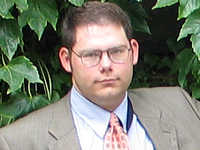
Greg Yochum, 36, is our Horticulturist. In spite of his young age he has been with us for more than 20 years, joining us as a groundskeeper and parking attendant when we were developing Station Square. He went on to obtain a degree in horticulture from CCAC, and we offer his knowledge and experience under contract services for Landmarks Development Corporation as well as utilizing that knowledge in regard with our landscape and garden preservation programs. He has participated in and spoken at seminars in the U.S. and abroad and is active with the American Chestnut Foundation in trying to reestablish the American Chestnut Tree, which has fallen victim nationwide to a fungal blight. -
Fairbanks Feature: A New Train of Thought – Two Important Donated Railroad Atlases Ready for Patron Use
James D. Van Trump Library | Frank B. Fairbanks Transportation Archive | Fairbanks Features

Showcasing a variety of materials located in the Frank B. Fairbanks Rail Transportation Archive
No. 3 Presentation
Two Important Donated Railroad Atlases Ready for Patron Use
Grant’s Railroad & Business Atlas, with Index to the U.S. and Canada (1887)
Cram’s Standard American Railway System Atlas
Index to U.S., Canada and Mexico Maps, also of Yellowstone National Park (1901)
Modern maps and atlases show major automobile highways; atlases of the late 1800s and early 1900s show the highways of those times––railroad lines. Two very special atlases are available for the patron who visits the Fairbanks Archive. Both are in excellent condition. They are able to be opened and laid flat, so that all lines flow smoothly from one page to the next. The books are oversized, approximately 14 x 18 inches, and in full color. The five photos below show the following:
- The title pages of both Railroad Atlases. Reading the information on these pages shows the completeness of these volumes that even include the post offices located in the various cities.
- Page 28 of Grant’s Railroad & Business Atlas, listing the 76 railroads running in Pennsylvania in 1887 and their routes.
- Judith Esposito holding the Grant’s Railroad & Business Atlas, donated by her to the Archive. This atlas was in Judith’s family for many years and was donated in honor of her father, Lewis H. Anderson (1917-1988), a career railroader.
- PHLF trustee David A. Vater donated Cram’s Standard American Railway System Atlas (1901) on December 22, 2006, on the occasion of the re-dedication and opening of the current Fairbanks Archive in its present location. On page 58-59 of the atlas, 90 different railroads are shown in operation in western Pennsylvania.
- Page 500-501 of Cram’s Standard American Railway System Atlas shows a map of Pittsburgh and Allegheny City. Major streets and the rail lines of 1901 are clearly shown in this map.
The Frank B. Fairbanks Rail Transportation Archive is open by appointment on Wednesdays, from 10:00 a.m. to 5:00 p.m. Use of the archive is free to PHLF members (one of the benefits!); non-members are assessed a $10 use fee.
The Archive is located on the fourth floor of The Landmarks Building at Station Square, in the offices of the Pittsburgh History & Landmarks Foundation.
To schedule an appointment, email James the Librarian James Halttunen: James@phlf.org





